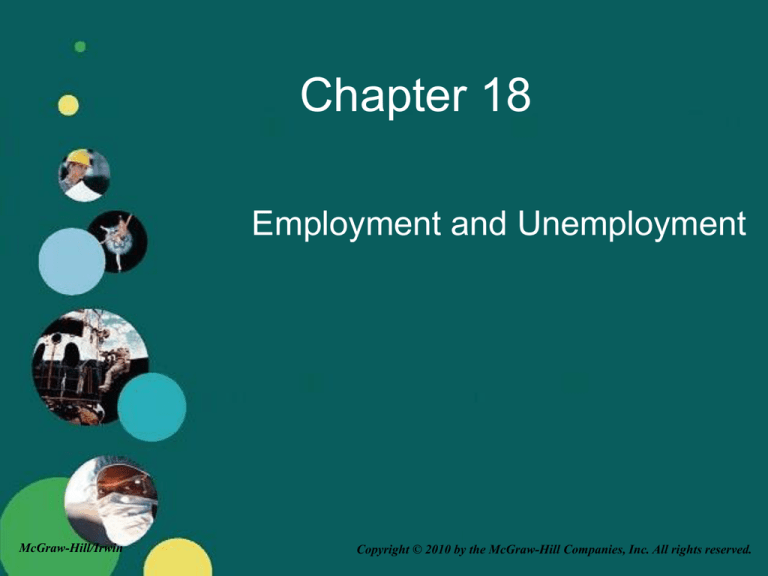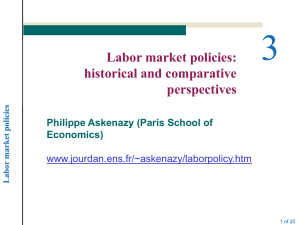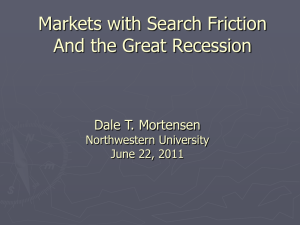
Chapter 18
Employment and Unemployment
McGraw-Hill/Irwin
Copyright © 2010 by the McGraw-Hill Companies, Inc. All rights reserved.
1. Employment and
Unemployment
Statistics
18-2
Employed Persons
o Employed persons include those 16
years of age and older who are either:
• employed by a private firm or a
government unit
• self-employed
• had jobs but were not working because
of illness, bad weather, etc.
18-3
Employment-Population
Ratio
employed persons
Employment* 100
Population Ratio = noninstitutional population
16 years of older
For June 2009:
EmploymentPopulation Ratio =
154,926,000
235,655,000
* 100 = 65.7%
18-4
Unemployed Persons
o Unemployed persons include those 16
years of age and older, who are not
working but are available for work, and
either:
(1) engaged in some job-seeking activity in
the past 4 weeks
(2) were waiting to be called back to a job
from which they were temporarily laid off
(3) would have been looking for job but were
temporarily ill
(4) waiting to report for a new job within 30
days
18-5
Unemployment Rate
Unemployment =
Rate
unemployed persons
unemployed + employed * 100
persons
or
Unemployment
=
Rate
unemployed persons
labor force
* 100
For June 2009:
=
LFPR
14,729,000
154,926,000
* 100 = 9.5%
18-6
• The
employmentpopulation ratio
has risen over
the past 4
decades.
Employment-Population Ratio
Employment-Population Ratio
66%
64%
62%
60%
58%
56%
54%
52%
50%
1960 1965 1970 1975 1980 1985 1990 1995 2000 2005
Employment-Population Ratio
18-7
Unemployment Rate
• The
unemployment
rate been highly
variable over the
past 4 decades.
Unemployment Rate
12%
10%
8%
6%
4%
2%
0%
1960 1965 1970 1975 1980 1985 1990 1995 2000 2005
Unemployment Rate
18-8
Advantages of Household Survey
o The unemployment rate and
employment-population ratios come
from a monthly household survey which
has the following advantages:
•
•
•
•
Time-consistent and large survey
Time lag in obtaining data is short.
Data is available on a disaggregated basis.
The unemployment rate provides
information about the business cycle.
18-9
Disadvantages of Household
Survey
o The monthly household survey has the following
disadvantages:
• Part-time workers are counted as fully employed
even if they wanted to work as a full-time worker.
• Unemployed persons must be actively seeking work.
• It does not measure persons who are subemployed.
• Persons may provide false information.
• All unemployed persons are counted equally.
• The data contain no information about minimum
acceptable wages.
18-10
Stock-Flow Model
• At any point in time,
there is a measurable
stock of people in
each of the three
boxes that represent
categories of labor
force status.
• But these stocks are
simultaneously being
depleted by flows in
and out of each
category.
Population Not in the Labor Force
Unemployed
Employed
• Changes in the
rates of these flows
can significantly affect
the unemployment
rate.
18-11
Determining Full Employment
o Some unemployment is voluntary and some
unemployment is involuntary.
o The natural rate of unemployment is:
• The unemployment rate at which there is
neither excess demand nor excess supply in
the labor market, or
• The unemployment rate that will occur in the
long run if the expected and actual rates of
inflation are equal.
o The natural rate of unemployment changes
over time.
18-12
Question for Thought
1. Do you expect the natural rate of unemployment
to (a) increase, (b) decrease, or (c) remain at the
present level over the next decade? Explain your
reasoning.
18-13
2. Macroeconomic Output
and Employment
Determination
18-14
Aggregate Demand
o Aggregate demand for goods and
services indicates the total quantity of
goods and services that domestic
consumers, businesses, government,
and foreign buyers will collectively desire
to purchase at each price level.
18-15
Aggregate Demand
o The aggregate demand curve slopes downward
because of the
• Interest rate effect
∞ A lower price level will reduce money demand and thus interest
rates.
∞ The lower interest rate will increase spending on goods such as
housing.
• Wealth or real balances effect
∞ A lower price level will increase the real value of assets whose
value is fixed in nominal terms and thus raise spending.
• Foreign purchases effect
∞ A lower price level will reduce the price of U.S. goods relative to
foreign goods and so foreigners will increase their spending on
U.S. goods.
18-16
Aggregate Supply
o Aggregate supply of goods and services is
the relationship between the price level and
total quantity of real output that firms are
willing to produce and offer for sale.
• The aggregate supply curve is upward sloping below
the natural rate of output.
∞ Since wages are inflexible downward, a decrease in demand will
result in layoffs and reduce output.
• The aggregate supply curve is vertical at the natural
rate of output.
∞ Greater demand increases can’t increase output since the
economy is at full-employment.
18-17
Real Output Determination
• The intersection of the
aggregate demand and supply
curves D and SkASc produces
equilibrium price and real
output levels P0 and Qn.
Price
Level
Sc
P0
A
D
Sk
Qn
Real Output
18-18
Employment Determination
• In the aggregate labor market, Wage rate
the equilibrium wage rate and
level of total employment are
determined by the intersection
of the aggregate labor demand
supply curves.
W0
SL
• Employment level En is the
natural rate of employment; it
is the amount of labor needed
to produce the natural level of
real output.
DL
En
Employment
18-19
3. Frictional
Unemployment
18-20
Frictional Unemployment
o Frictional unemployment is
unemployment due to voluntary quits,
job switches, and new entrants or
reentrants into the labor force.
o Sources of frictional unemployment:
• Search unemployment which is caused by
individuals searching for the best wage
offer and firms searching for workers to fill
job openings.
18-21
Frictional Unemployment
• Wait unemployment which is caused by the
excess supply of workers that results from
non-market clearing wages.
∞Temporary layoffs
~ Workers on temporary layoff usually don’t search for
another job.
∞Union job queues
~ Workers may wait in a union job queue rather than take
a nonunion job.
∞Efficiency wages
~ Efficiency wages contribute to frictional unemployment
since firms pay high wages to increase worker
productivity.
18-22
4. Structural
Unemployment
18-23
Structural Unemployment
o Structural unemployment is
unemployment due:
• Mismatch between the skills required for
available job openings and the skills
possessed by those seeking work.
• Geographic mismatch between the
locations of job openings and job seekers.
• Workers losing jobs because of permanent
plant closing or job cutbacks.
18-24
5. Demand-Deficient
Unemployment
18-25
Demand Deficient Unemployment
• A decline in aggregate
demand reduces the demand
for labor (from DL to DL1).
• Assuming a rigid nominal
wage W0, the decline in labor
demand results in involuntary
demand-deficient
unemployment by the amount
ab.
Wage rate
SL
W0
b
a
DL
DL1
E1
En
Employment
18-26
Wage Rigidity
o Nominal wages are inflexible downward
is unemployment due to:
•
•
•
•
Unions
Bias toward layoffs by firms
Implicit contracts
Insider-Outsider theories
18-27
Question for Thought
1. Define the term structural unemployment and
distinguish it from frictional and demanddeficient unemployment. Why might structural
unemployment fall when demand-deficient
unemployment declines?
18-28
6. The Distribution of
Unemployment
18-29
Distribution of Unemployment
o Unemployment rates are higher for:
• Less skilled workers
• Teenagers
• African Americans
o Men and women now have
unemployment rates that are very similar.
o The percentage of persons unemployed
for a long duration (15+ weeks) rises
during recessions.
18-30
7. Reducing
Unemployment:
Public Policies
18-31
Reducing Unemployment
o Expansionary fiscal and monetary policy can be
used to reduce demand-deficient unemployment.
o Complications arise from conducting stabilization
policy.
• Time lags
∞ It takes time for changes in policy to affect the unemployment rate.
• Crowding out effect
∞ Higher government spending causes the government to borrow
more funds and thus raise interest rates and reduce private
spending.
• Tendency to create inflation
18-32









